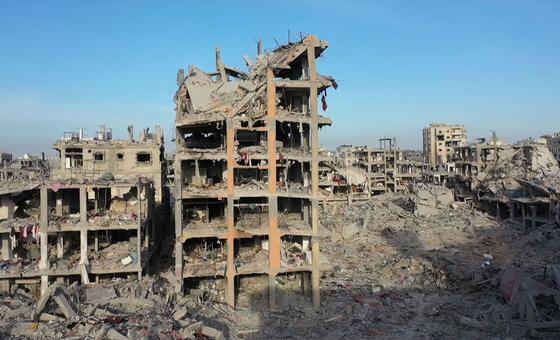Ceasefire offers ‘lifeline’ but Gaza hospitals remain in ruins
Tedros Adhanom Ghebreyesus welcomed the halt in hostilities but said “the crisis is far from over and the needs are immense.”
He highlighted the toll of months of conflict: more than 170,000 people injured –including 5,000 amputees and 3,600 people with severe burns. At least 42,000 require long-term rehabilitation, and 4,000 women give birth each month “in unsafe conditions.”
Psychological wounds
“The destruction has been physical but also psychological,” he said. “An estimated one million people need access to mental health care.”
Tedros described a system on the brink of collapse. “There are no fully functioning hospitals in Gaza, and only 14 out of 36 are functioning at all,” he said, citing “critical shortages of essential medicines, equipment and health workers.”
Since the ceasefire took effect two weeks ago, WHO teams have scaled up support, sending medical supplies to hospitals, deploying emergency medical teams, and facilitating evacuations.
“Yesterday, we supported the evacuation of 41 patients and 145 companions to several countries,” Tedros said, thanking over 20 nations that have received evacuees.
700 dead waiting for evacuation
But with 15,000 patients still in need of treatment outside Gaza – including 4,000 children – he stressed that “more than 700 have died while waiting for evacuation.”
He urged the reopening of the Rafah crossing and the restoration of medical referrals to the occupied West Bank, including East Jerusalem, to enable urgent care and expand aid delivery.
“Although the flow of aid has increased, it’s still only a fraction of what is needed,” Tedros said, noting that “a significant amount of aid has built up at Al-Arish in Egypt” awaiting the reopening of Rafah at the southern tip of the enclave.
The UN’s 60-day ceasefire plan seeks $45 million to maintain essential health services, strengthen disease prevention and early warning systems, coordinate health partners and support reconstruction.
Rebuilding Gaza’s health system, however, will cost “at least $7 billion,” he said. “WHO was in Gaza before the war started, we have been there throughout, and we will stay there to help the people of Gaza build a healthier, safer and fairer future.”
Aid and access
In New York, UN Deputy Spokesperson Farhan Haq said the UN and partners are stepping up relief efforts. A UN team recently reached Gaza City’s Az Zaitoun neighbourhood – inaccessible before the ceasefire – where more than 200 returning families live in “extremely poor” conditions.
Residents walk up to two kilometres to reach the nearest water point and urgently need food, clean water, hygiene items and cash assistance for winter essentials.
Meanwhile, UN agencies continue to deliver vital aid. The World Food Programme (WFP) is distributing fortified snacks to schoolchildren, while more than 140 trucks of food, hygiene kits and emergency shelter items entered Gaza earlier this week.
Children’s agency UNICEF has delivered 20 trucks of baby diapers, and crisis operations hub UNOPS distributed nearly 160,000 litres of fuel for humanitarian operations.
“The ceasefire offers a lifeline,” said Tedros, “but Gaza’s health system – and its people – are still fighting for survival.”
















Leave a comment